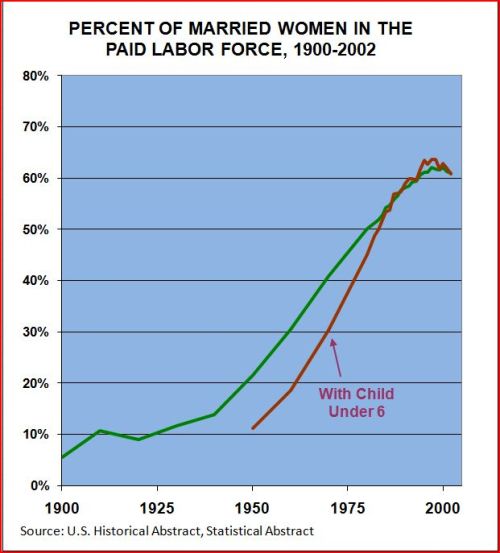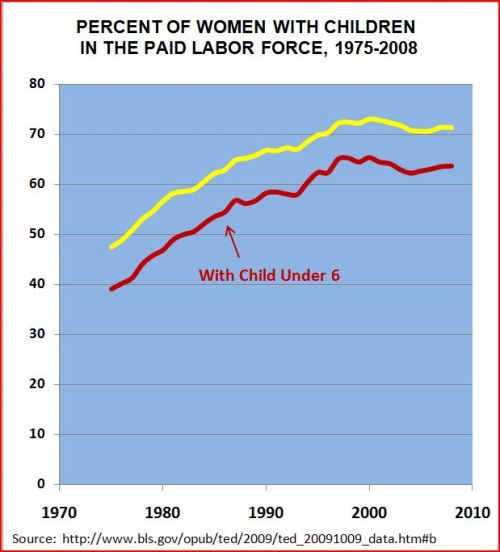What’s the biggest change in the American way of life in the last 50-60 years? There are a lot of candidates: the coming of new technologies, especially the computer and internet; the end of the post-war boom and the start of economic stagnation for average Americans; much more liberal and open sexual mores; the dismantling of the racial caste system capped by the election of a black president; and so on. These were all important, but my candidate for the Big Change Award is this: Mom goes to work.
To be sure, mothers always worked – at home for their families, doing housework and childcare. And many mothers also worked at home for pay – farm women churning butter or gathering eggs for sale; poor urban women indoors spinning, weaving, and sewing, paid by the piece. Some mothers, particularly African and Irish American mothers, worked away from home, usually as servants and maids. Still, in the early 20th century, relatively few American mothers with children at home, rarely those with young children, went out to work. Then everything changed. And then maybe the change stopped.
Mom Goes to Work
The figure below, drawn from census data, shows two stunningly dramatic changes between 1900 and 2002. The longer, top line tracks the percentage of married women who were in the paid labor force; we have numbers on them going back to 1890. In 1950, 22% of married women worked for pay; by 2000, 62% worked for pay. (These data, by the way, belie the conventional story that working women, the Rosie-the-Riveters, were in any large numbers driven out of the labor force after the war.) The lower, shorter line displays the percentage of married women with a child under 6 years old who worked for pay; we have numbers on them going back only to 1950. In that year, about 1 out of 10 mothers of small children worked; in 2000, more than 6 in 10 did!
One rarely sees social change of this magnitude in a settled society over only about two generations. Economic growth, technological marvels, political shifts, and the like seem glacial by comparison.
Why did mom go to work? Or, to be more precise, why did more single women keep working after they married and had children and why did more mothers return to work while their children were so young (see Ch. 5 here)? Many scholars have addressed the topic in detail and I can only present a simplified gloss here. First, work changed to offer more jobs to women. Farming declined sharply; industrial jobs peaked and then declined. Brawn became less important; precise skills, learning, and personal service became more important. The new economy generated millions of white-collar and “pink-collar” jobs that seemed “suited” to women. That cannot be the full story, of course; women also took over many jobs that had once been men’s, such as teaching and secretarial work.
Second, mothers responded to those job opportunities. Some took jobs because the extra income could help families buy cars, homes, furnishings, and so on. Some took jobs because the family needed their income to make up for husbands’ stagnating wages (a noteworthy trend after the 1970s). And some took jobs because they sought personal fulfillment in the world of work.
What were the consequences of so many more mothers working? Cities could be built with the articles and books that have debated – often heatedly, emotionally – the answer to this question. Were mothers selfishly damaging their children or were they instead enriching their children by going off to work? What did the wife’s paycheck mean for the man’s ego and the marriage’s stability? How do women in the workplace change the way work gets done? These questions are still argued and researched by social scientists.
Whatever the answers, some social byproducts of the great move to jobs seem evident (at least to me). One is the loss of much of the free labor that used to staff local associations – garden clubs, PTAs, church sisterhoods. Another was the thinning of neighbor-to-neighbor connections, as housewives became fewer (and working wives frantically tried to get their housewifery completed when they were home). Perhaps most profound is that the expectation, the norm, turned upside down.
In 1950, the working wife was unusual and the working mother of a small child hardly seen. Sixty years later, the non-working wife is unusual and almost two-thirds of mothers with small children work at least part-time. The older among us can remember when a mother with children at home who worked had to, with some embarrassment, explain why. She might perhaps say that a temporary set-back to her husband’s business led her to get a job. And we can remember when the tide shifted and a mother who did not work for pay had to explain why. Perhaps she might say that little Johnnie had some problems adjusting to day care, but that she would soon get back to her career.
The dramatic shift in norms changed some of our political debates. There was a time, for example, when poor, single mothers who worked were considered by the community and the authorities as unfit mothers; they should stay home and tend to their children. Nowadays, the community and authorities often treat poor, single mothers who stay home with their children as lazy no-goods; they should earn a paycheck. If most American mothers go out to work, people seem to say, why can’t these women?
The End of Revolution?
Between 1950 and 2000, the percentage of married women and those with young children who worked sky-rocketed. A close look at the figure above suggests that the rocket may have reached its apogee in 2000.
The figure below provides a closer look. It presents data for mothers irrespective of marital status, a reasonable shift in focus given the much higher proportion of women who are rasing children either before or after marriage. The upper line shows the percentage of all women with a child under 18 at home who were in the labor force, 1975-2008; the lower line focuses on mothers with at least one child under 6 at home. The lines display the rapid increase in working mothers from 1975 to the late 1990s. But then the rates level off. (The numbers do not yet reflect the full surge of male unemployment that started in mid-2008.)
What does this leveling off represent? Have we reached some sort of ceiling effect? Perhaps the nature of child-bearing and child-rearing in the United States is such that Americans will never push past a rate of about 70% employment for mothers. (Crossnational data suggest that in some other western nations these rates go perhaps 10 points higher.) American jobs or American childcare policies may not keep the trend going up. Alternatively perhaps, the leveling off may presage a cultural shift, the beginnings of a purposeful move back into the home by women, something a few observers have argued is starting to happen.
In any case, it is hard to imagine undoing the great social revolution of the twentieth century, of ever getting back to where we came from only 50 or so years ago, of unraveling the Big Change, when mom went to work.
(This column was cross-posted on The Berkeley Blog on March 2, 2011 and on The Public Intellectual on June 8, 2011.)
Update (1/18/16):
A piece of research trying to identify why this employment trend leveled off around the turn of the century (h/t Tyler Cowen):
So Kubota, Child Care Costs and Stagnating Female Labor Force Participation in the US
The increasing trend of the female labor force participation rate in the United States stopped and turned to a decline in the late 1990s. This paper shows that structural changes in the child care market play a substantial role in influencing female labor force participation. I first provide new estimates of long-term measures of prices and hours of child care using the Survey of Income and Program Participation. Hourly expenditure on child care rose by 40% and hours of daycare used declined by 20%. Next, I build a life-cycle model of married couples that features a menu of child care options that captures important features of reality. The calibrated model predicts that the rise in child care costs leads to a 5% decline in total employment of females, holding all else constant. Finally, this paper provides two hypotheses and their supporting evidence about the causes of rising child care costs: (i) restrictive licensing to home-based child care providers, and (ii) the negative effect of expanded child care subsidies to lower income households on the incentives for those individuals to operate the home-based daycare.
BUT.. Kevin Drum looked at this study and is skeptical:
What it shows is clear: participation rates for women with children declined less than rates for women without children.
What am I missing here? It seems perfectly sensible that rising childcare costs reduce the net income from market labor and therefore reduce the number of mothers who find it worthwhile to work outside the home. And I’m fully willing to accept that the costs of childcare have gone up over the past couple of decades. That should make a difference, and Kubota estimates that it’s reduced female labor force participation by 5 percent. But Kubota’s own chart suggests that it hasn’t had this effect.
So… why are labor force participation rates for mothers declining less than those for women without children? That’s a genuine mystery.
Update (3/10/22):
Landon Schnabel and colleagues published a study on trends in gender differences in attitudes toward working. They track change in answers to a General Social Survey question that reflects, they believe, commitment to “the work ethic”: “If you were to get enough money to live as comfortably as you would like for the rest of your life, would you continue to work or would you stop working?” Circa 1980, American men were about 10 points likelier than American women to say yes, about 78 to 68 percent. In the late 2010s, both were at about 71 percent. Complex analysis shows that the convergence was about equally due to men’s decline in endorsing the question as women’s increase. Unfortunately, the data do not go back another 20 years where, as we see in the first figure above, the biggest change occurred. The 2000s actually witnessed a moderation.






[…] percentage of married women in those ages who worked for pay rose from about 5 to about 65. This social revolution liberated women from their fathers and from their husbands. The “dual-earner” couple became […]